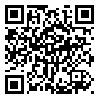Volume 13, Issue 49 (Water and Soil Science 2009)
jwss 2009, 13(49): 153-164 |
Back to browse issues page
Download citation:
BibTeX | RIS | EndNote | Medlars | ProCite | Reference Manager | RefWorks
Send citation to:



BibTeX | RIS | EndNote | Medlars | ProCite | Reference Manager | RefWorks
Send citation to:
Soffianian A. A Study on Land Use Change in Isfahan Using. jwss 2009; 13 (49) :153-164
URL: http://jstnar.iut.ac.ir/article-1-988-en.html
URL: http://jstnar.iut.ac.ir/article-1-988-en.html
, soffianian@ac.iut.ir
Abstract: (32966 Views)
Monitoring Land Use and Land Cover Changes have a significant role in environmental programming and management. Satellite data is an essential tool for detecting and analyzing environmental changes. Many change detection techniques have been developed which have advantages or disadvantages. Change Vector Analysis (CVA) technique is one such a method. This method is based on radiometric changes between two dates of satellite imagery. Main advantage of this method is that it provides direction and magnitude image of change. The aim of this study was to describe change vector analysis technique and it applies to detect land cover change in Isfahan area during an 11-year period. The data used for this study were two images Landsat: TM 05 June 1987 and 03 June 1998. Correction radiometric was not carried out because of the similar sensor and acquisition time of the remote sensing data. After geometric correction, the study area was selected from Landsat images. Change vector technique was applied to analyze magnitude and direction of change. The change map showed Kappa and overall accuracy coefficient of 63.19% and 74.4%, respectively. The results showed that the changed land cover was 3340 ha during this period. Overall, the results show that 1325 hectares (especially agricultural lands) have been converted into urban areas, agricultural areas were increased up to1385 hectares, and 435 hectares of agricultural areas were converted to other land use over the period of study. This study showed that CVA is a robust approach for detecting and characterizing radiometric change in multi-spectral remote sensing data sets.
| Rights and permissions | |
 |
This work is licensed under a Creative Commons Attribution-NonCommercial 4.0 International License. |





